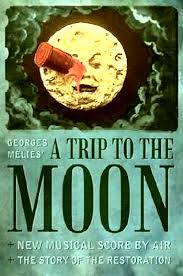
Professor Barbenfouillis is the president of a society of Astronomers. They are meeting to discuss an expedition to the Moon. After much heated discussion five other astronomers volunteer for the journey. They are Nostradamus, Alcofrisbas, Omega, Micromegas and Parafaragaramus. Plans are drawn up and the bullet shaped capsule and huge cannon are built.
After much fanfare the astronomers are given a rousing send off. The cannon is fired and the capsule sails into the stratosphere. The capsule lands directly into the eye of the man in the Moon. The astronauts disembark from the capsule and watch the Earth rise. Exhausted from their trip they lay down and go to sleep. The stars, a comet and other heavenly bodies dance while they sleep. Phoebe, the goddess of the moon causes a snowfall and the astronauts wake up.
They seek shelter in a cave where they find giant mushrooms and insect-like creatures living underground. The creatures are called Selenites. They capture the astronauts and bring them to the Selenite king. The astronauts escape the Selenites and race back to their capsule.
Barbenfouillis uses a rope to tip the capsule off a cliff giving it momentum for the trip back to Earth. Barbenfouillis holds on to the rope for the trip back. Just before the capsule takes off a Selenite jumps on top of it and rides it back to Earth where it lands in the ocean.
When the astronauts area safely back on Earth there is again much fanfare, a parade, which includes the Selenite on display, and a statue in their honor. The statue reads “Labor omnia vincit”, “Work conquers all”.
“A Trip To The Moon” AKA “Le Voyage dans la lune” was released in 1902 and was written, produced and directed by Georges Melies. Georges himself plays the part of Barbenfouillis. The film is about 13 to 15 minutes long. It is roughly based on Jules Verne’s stories “From the Earth To the Moon” 1865 and “Around the Moon” 1870. Many point out that H.G. Wells’ “First Men In the Moon” 1901 must also be an influence. Georges had planned to show the film in the US hoping to make a lot of money; however, the film was pirated by Edison’s film technicians and other studios.
The film was extremely popular and considered cutting edge for its production values and special effects, plus its unusually long length. Some of the original prints were individually hand-colored by Elisabeth Thuillier's coloring lab in Paris. It was one of the first science fiction films. The scene where the capsule lands in the eye of the “Man in the Moon” is one of the most iconic images of the silent movie era.
Eventually the film went into obscurity until 1930. Fans of the history of cinema and of Melies in particular realized the importance of the film and of Melies’ contribution to the industry.
No hand colored prints were known to have survived until an original hand-colored print was discovered in 1993. It was badly decomposed. Many trials and many years later a complete restoration was done and in 2011 it was exhibited at the Cannes Film Festival.
The score for the film was done by the French Electronica duo “Air”. A controversial choice, however, Melies never required a specific score for his films. He allowed exhibitors the freedom to decide whatever accompaniment they felt most suitable.
Many have theorized on the theme of the film. Everything from Pataphysical, to anti-imperialist. The satire is there among the beautiful hand painted colors and great special effects and it is important to understand the symbolism Melies intended to express, but it’s the lively spirit and subtle humor that I enjoyed the most. All in all this beautifully restored fantasy is absolutely delightful and at only 15 minutes it is very quick.

